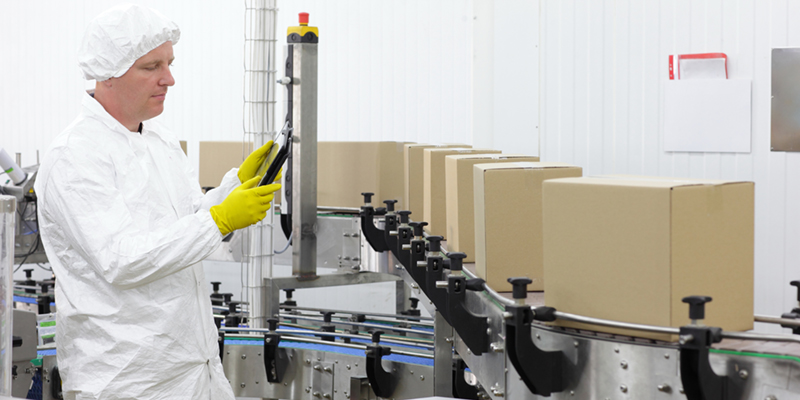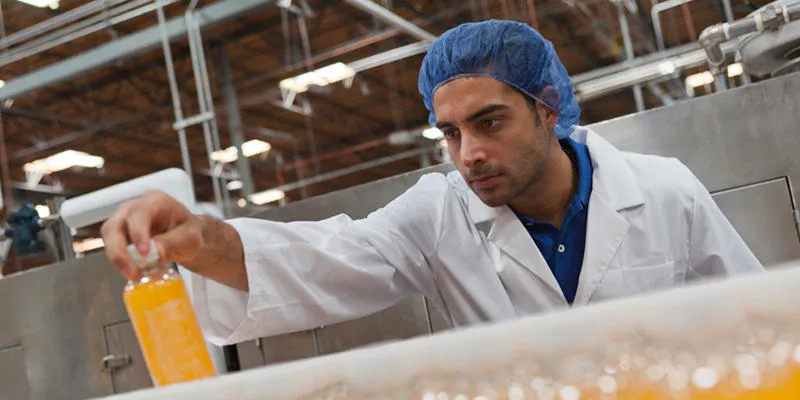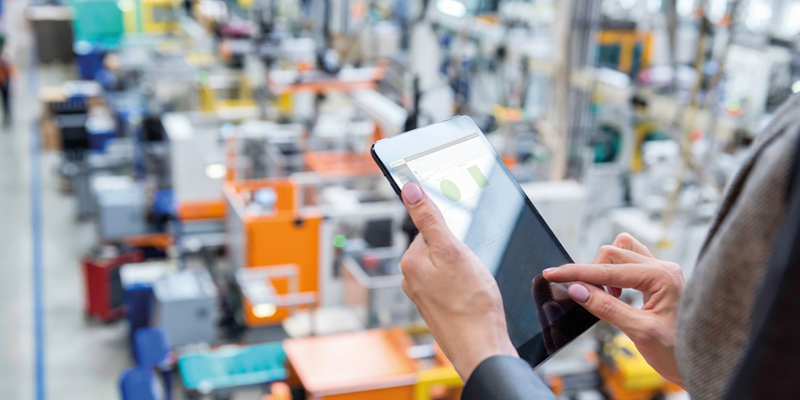Over the past few months, the COVID-19 pandemic has dramatically changed the way we live and work. Today, organisations of all kinds are being forced to abandon traditional processes and find new ways of working in order to remain operational – and many have turned to technology to make this possible.
Whether it is adopting new systems to enable working from home, shifting to online collaboration tools including Zoom, WebEx, Skype, and Microsoft Teams, or setting up ecommerce stores to continue operation – the onus has been on technology and connectivity to keep things moving.
For those in manufacturing, working from home during the COVID-19 pandemic is not an option, but continuing business as usual in the current climate is not without its challenges. This is particularly true for those working to produce essential items including food and beverages, pharmaceuticals, and medical devices, for which demand has never been greater.
How can manufacturers ensure the continued operation of their production lines while ensuring the health and safety of their frontline workers? It’s a question that can be answered by expediting the factory of the future, or more specifically, by utilising integration and automation in manufacturing operations.
In this blog, we speak to Adem Kulauzovic, Director of Coding Automation at Domino, about the relevance of Industry 4.0 in the era of COVID-19, and highlight some of the ways that integrated systems, connected devices, and automated processes can be used to help ease production strain during the COVID-19 pandemic.

Reduce worker stress
To keep things running during the COVID-19 pandemic, businesses need to ensure that workers are looked after, and reducing worker stress and promoting good mental health has been a huge conversation topic in recent months.
With swathes of people across the world adjusting to new work environments, the onus has been on employers to ensure that their personnel are kept happy and healthy.
“A lot of people are finding working from home stressful because they are having to adjust to a new environment and a new way of doing things,” says Kulauzovic. “The same is true of workers on the factory floor – where social distancing measures and new shift patterns and processes are adding additional stress during already difficult times.”
Production line work can be stressful at the best of times, especially where workers are manually entering codes, or performing the same, small task over and over again. These tasks, though business-critical, can be some of the most mentally fatiguing of all production line tasks, and as such are also prone to operator error.
Manufacturers can help to alleviate some of the stress, while also eliminating a key area where errors in production may arise, by taking care of routine, business-critical processes through automation and integration. Utilising Industry 4.0 in this way can also stand to benefit manufacturers coping with staff shortages due to sickness, quarantine, or self-isolation during the COVID-19 pandemic.
“When you have an increase in staff sickness, the first thing you do is ask for more help or bring in temporary workers to support remaining staff,” says Kulauzovic. “A lot of businesses are doing this now, but they do not have the time, or the capacity to offer the same level of training or assistance as they would do in normal situations.”
“By automating routine tasks, and simplifying processes, manufacturers can make it easier for new personnel to come in and provide support when required,” he continues. “Provide that simplicity and you will make continuing operations during this time a lot more manageable.”
Automation in manufacturing during the COVID-19 pandemic
Prior to the COVID-19 pandemic, the business drivers of Industry 4.0 were all focused on the competitive advantage that could be achieved through integration, automation, and big data – including reduced costs and increased productivity.
Today, the technology and the benefits are the same, but the focus is on adaptation.
Industry 4.0 is all about state-of-the-art technology, built-in sensors, and most importantly, connectivity – between machines, people, and places. Social distancing’s impact on the ability for workers to interact on the production floor means that connectivity can also be a powerful tool for manufacturers to both keep production moving and ensure the continued safety of their staff.
By utilising Industry 4.0 processes, and automating systems to work with limited operator intervention, manufacturers can reduce the number of workers needed on the plant floor. Integrating plant machinery and utilising the cloud can provide visibility and operation remotely, allowing managers to work away from the line and yet stay in on top of all production activity.
“A lot of Domino’s customers are looking at ways to utilise automation in manufacturing to reduce the need for manual intervention so they can reduce the number of team members needed on site at any one time,” says Kulauzovic. “The fewer people you have in the plant the better you can be at preventing the spread of disease and keeping workers safe.”
Prior to the COVID-19 pandemic, 54% of new US production lines were being set up for automation, or to be controlled by programmable logic controllers. With the challenges presented by COVID-19, this is expected to increase. It has even been suggested that electronics manufacturing could witness five years’ worth of development in the next 18 months – all as a result of production challenges brought about by COVID-19.[i]
Working from home
“Around the world, those people who can work from home are being asked to,” says Kulauzovic. “If you can’t currently do your job from home, there could be a solution, utilising automation, or the cloud, which could enable you to do this.”
For example, sharing manufacturing data on the cloud could allow a maintenance manager to work remotely to monitor machinery – only going onto the site when fully necessary to solve a problem.
Domino printers equipped with the Domino Cloud Interface, for example, are equipped to send performance information to the Domino Cloud – where it can be viewed remotely by the customer and Domino Helpdesk staff. The information can be used to monitor machine functionality, and perform predictive maintenance tasks, where necessary, to keep printers running, or to troubleshoot issues as they occur.
Equally, automating simple, system-critical processes, such as data entry, information distribution, and product changeovers can limit the number of manual workers required on a production line. Utilising solutions to monitor production from a central location – such as a single computer, or home office – can allow for workforce numbers to be reduced to only critical staff who need to be there to operate the machinery.
By automating systems, monitoring processes, and troubleshooting issues remotely, you can continue to provide a safe environment for frontline workers, in turn helping to continue productivity during the COVID-19 pandemic.

Debunking the automation myth
A common myth with Industry 4.0 and automation is that you are either in or you are out. In the current climate, manufacturers that are not currently set up for full automation may feel that there is nothing they can do to improve their processes at present; that by not implementing Industry 4.0 practices before the crisis they have missed the boat.
“It’s doesn’t have to be like that,” says Kulauzovic. “There are small things that you can do, states of progression which can help out in these trying times – you don’t have to have a fully automated solution to reap the benefits.”
From a coding and marking perspective, there are small processes and concepts which either partially automate or make it easier for an operator to do their job while working on a production line with reduced staff numbers or a significantly increased workload.
Networking printers together using coding automation software, such as Domino QuickDesign, can allow production line staff to populate product labels and manage their distribution across multiple printers. This small adjustment can allow staff to manage label distribution from a central location, thereby reducing the number of workers required to manage coding processes across a production line.
With the simple application of IoT methodology, this can be taken a step further to allow coding solutions to automatically populate label templates from a central database – eliminating the need for manual data entry on a production line.
“The simple addition of a barcode scanner can allow an operator to automatically populate a label by scanning a production order barcode,” says Kulauzovic. “By introducing these small processes, you aren’t fully automating the system, but you are eliminating a lot of the complication and reducing the overall workload of staff on the line.”

Prepare for the future
In the run-up to the COVID-19 pandemic, the idea of Industry 4.0 was gaining traction as a modern phenomenon, no longer just in terms of the factory of the future, but as a system of ideas and processes which manufacturers could utilise in the present day to remain competitive and make the most out of their manufacturing operations.
“It’s during times like this that problems in production processes make themselves known,” says Kulauzovic. “By continuing production during a crisis, you can easily identify those areas in a business, or a single production line, that require the most improvement, and implement small fixes to address these issues on a micro-level.”
“By identifying areas where bottlenecks arise – during product changeover, for example – and implementing easy automated fixes to streamline processes you can very quickly start to realise the benefits in automation,” he continues. “Start small and implement these processes on a micro-level and the improvements will help to justify introducing additional automation farther down the line.”
By exploring options for coding automation today, manufacturers can not only overcome issues encountered on production lines arising due to the COVID-19 pandemic but can also place themselves in good stead to prepare for further crisis situations, should they arise in the future.
Talk to the experts
As we continue to navigate through these challenging times, there is no denying that it is no longer business as usual. The COVID-19 pandemic has made it clear that in order to continue operation now, and in the future, we must all think about how to embrace new efficiencies, new technology, and new modes of business.
Those manufacturers who took steps to automate their production lines prior to the COVID-19 outbreak may have found it easier to adapt their processes in order continue production during the current pandemic. While others may have found themselves having to abandon traditional processes in order to keep their doors open and ensure the continued safety of their staff.
Wherever you are in your journey, there has never been a better time to embrace automation in order to protect your workforce, your business, and your commercial future.
If you are still utilising traditional, manual processes on your production lines, or if you have already started to explore options for automation and are keen to find out more about the benefits of industry 4.0, please get in touch.
At Domino, we have years of experience working in the field of coding automation and global experts are on hand to help you to overcome the challenges posed by the current crisis.
Wherever you are on your journey, Domino is here to help. Whether you need to protect your people, protect your business, or protect your commercial future, contact our experts today to find out how.
[1] The Economist, “How to reopen factories after covid-19”, accessed 24th June 2020 https://www.economist.com/briefing/2020/04/07/how-to-reopen-factories-after-covid-19